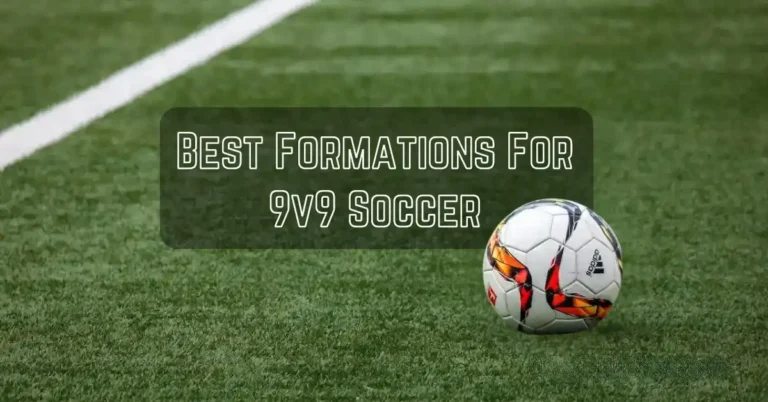Rules For Subs In Soccer – Some Rules You Should Know
Soccer, a sport loved and followed by millions globally, thrives on its dynamic nature, and one critical aspect that adds to its unpredictability is substitutions. Understanding the rules for subs is crucial for players, coaches, and fans alike.
Soccer, often referred to as the beautiful game, is a sport filled with excitement and suspense. One element that can significantly impact the flow and outcome of a match is the strategic use of substitutions.
What Is a Substitution in Soccer?

A substitution in soccer refers to the strategic act of replacing one player on the field with another during a match. It is a dynamic tactic employed by teams to optimize their performance, address injuries, or adapt to changing circumstances during the game.
How Does Substitution Work?
Substitutions are typically made during stoppages in play, such as throw-ins, goal kicks, or free-kicks, with the referee’s approval. The departing player must exit the field before the incoming player can enter, ensuring a seamless transition without disrupting the flow of the game.
See Also Goalkeeper Attributes
Why Does a Substitution Happen in Soccer?

Substitutions serve various purposes, including injury management, fatigue alleviation, and strategic adjustments. Coaches may also use substitutions to introduce fresh energy, exploit opponent weaknesses, or change the team’s tactical approach based on the evolving dynamics of the match.
Can a Substituted Player Come Back On?

In most soccer competitions, once a player has been substituted, they are not allowed to re-enter the field. This rule promotes fairness and prevents teams from exploiting the substitution system excessively for tactical advantages.
When Can You Sub in Soccer?
Substitutions can occur during stoppages in play, such as throw-ins, goal kicks, or free-kicks. The timing of substitutions is crucial, and coaches strategically choose when to make changes to maximize their impact on the game.
See Also Is Soccer Better Than Football?
All Rules for Subsitions in Soccer

This table shows all the rules for the substitutions in soccer that you should know.
| # | Rules For Subs | Description |
|---|---|---|
| 1 | Number of Substitutions | Three substitutions are allowed per team in a standard soccer match. |
| 2 | Substitution Timing | Substitutions can be made during stoppages in play with the referee’s approval. |
| 3 | Substituted Player Reentry | Once substituted, a player is generally not allowed to re-enter the field. |
| 4 | Injury Substitutions | Additional substitutions may be allowed for injured players, subject to the referee’s approval. |
| 5 | Goalkeeper Substitutions | Goalkeepers can be substituted under the same rules as outfield players. |
| 6 | Player Leaving the Field | Substituted players must leave the field at the nearest point, as directed by the referee. |
| 7 | Substitution Board | The fourth official displays a board with the jersey numbers of the incoming and outgoing players. |
| 8 | Failure to Leave Promptly | Delaying the departure of a substituted player may result in a yellow card. |
| 9 | Additional Substitutions in Extra Time | Extra substitutions may be allowed in knockout stages or competitions with extra time. |
| 10 | Competition-Specific Rules | Different competitions may have variations in substitution rules. |
| 11 | Notification to Referee | Coaches must inform the fourth official of substitutions, who then notifies the referee. |
| 12 | Substitute Bench Protocol | Substitutes must stay within the technical area and adhere to bench protocols. |
See Also How To Gain Stamina For Soccer?
Premier League Substitution Rules

- In the English Premier League (EPL), three substitutions per match are typically allowed.
- The league may implement temporary rule changes, such as allowing five substitutions in a match, based on specific circumstances.
- Teams can make additional substitutions for players with suspected head injuries, regardless of the three-substitution limit.
FIFA Substitution Rules

- FIFA sets the global standard for soccer rules, including substitutions, with a standard limit of three substitutions per team.
- Whether in international friendlies or competitive matches, FIFA’s rules for subs ensure consistency in applying the game’s regulations.
- The no-reentry rule for substituted players is designed to promote fair play and prevent tactical exploitation.
Champions League Substitution Rules

- Teams in the UEFA Champions League are allowed three substitutions per match, following the standard set by FIFA.
- Given the prestigious nature of the competition, coaches often strategically time substitutions to influence critical moments.
- In knockout stages or finals that go into extra time, additional substitutions may be permitted.
Olympic Soccer Substitution Rules

- Teams are allowed three substitutions per match during the Olympic soccer tournament.
- In case of injuries, teams can make additional substitutions beyond the standard three, subject to the referee’s approval.
- Substituted players must exit the field at the nearest point, following standard soccer substitution protocols.
FAQs
No, in soccer, a player who has been substituted cannot return to the field in the same match.
Teams can make three substitutions in a standard soccer match.
The 5-sub rule allows teams to make up to five substitutions in a match, providing increased flexibility.
No, once substituted in the World Cup, a player cannot return to the field during the same match.
Conclusion
Rules for subs in soccer are a fundamental aspect of the game, offering teams the flexibility to adapt and excel strategically. Understanding these rules across different competitions enhances the appreciation of the sport, revealing the tactical intricacies that unfold on the pitch. Whether in domestic leagues or prestigious international tournaments, substitutions play a pivotal role in shaping the narrative of soccer matches worldwide.







